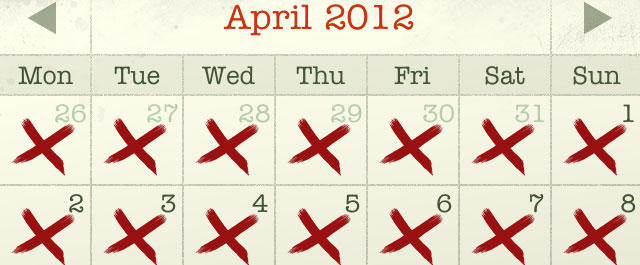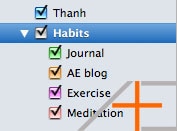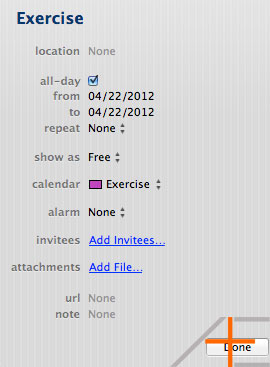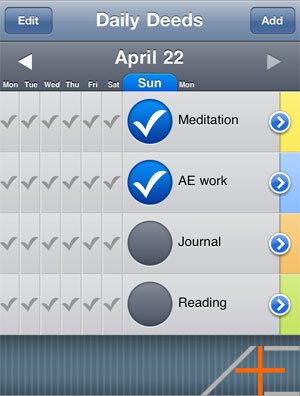
Do you want to know one of the keys to success? It is doing the little things every day that most people will never see and that help you get closer to your big goal. Success stories might seem like sudden overnight successes, but people usually never get to see all the tiny things that led to the big success. If you want to enjoy massive success, you need to start working on your big goal every single day so it becomes inevitable that you will get to where you want to be. We are going to show you how you can work on your daily actions by using the Don’t Break The Chain productivity method.
The best way to work each day on your big goal is to make it habitual. This seems to be a challenge for most people, especially dealing with the daily procrastination, but we have found that the Don’t Break The Chain method is an effective solution for this. This method was supposedly popularized by Jerry Seinfield. When he was an aspiring comedian he needed to improve his standup material, and he constantly needed to come up with new material. His solution? Write every single day and mark it off on a calendar with a big X. After writing each day he would have a chain of marks on his calendar and he was motivated to not break that chain. That kept him motivated to write each day as he saw his chain become longer and longer, and that is how this productivity method was born.
The basic idea is that you use the chain of marked off days as your motivation to keep the streak going. It is a very simple concept but also a very effective method for building habits and helping you work each day on your big goal.
Tips
While the idea behind Don’t Break That Chain is very simple, there are a lot of nuances you want to be aware of. Here are some tips to get you started and to help you utilize this technique in the best way possible.
One activity first
It’s tempting to try to learn multiple habits at the same time, but if you have never used this technique before we recommend you start with one habit at a time. Good daily habits you can acquire include:
- Exercise
- Writing / blogging
- Meditate
- Eating fruits
- Floss
- Read
Not only can you use this method for building habits, but it is also great to force you to work on your big goal every day. Everyone’s goals are different so it is up to you to figure out which activity is something you want to do each day. If you want to be a full-time blogger, you can say that working on your blog each day is a must. Or if you want to get straight As, study every day.
Why
Before you start implementing this technique – you first need to be clear with yourself why you want to do this. Write it down on your calendar or on a piece of paper why you want to start doing this particular activity every single day.
If you want to exercise every day, you could write “I want to live a healthier lifestyle.” Or if you want to meditate every day, you could write “I want to feel refreshed and calm before I start my day.”
Write down why you want to do this – this clarity will help you motivate yourself.
Rewards

People tend to succeed better when they know there is a reward at the end of the journey. This is especially true for building new habits. Setup a reward for yourself for completing a streak of one month. It is important that you write down what the reward is before you start the Don’t Break The Chain technique.
Examples of rewards could include:
- Dinner at your favorite restaurant.
- A getaway weekend.
- Buying yourself a gift.
No matter how big or small the reward, it is important to have one. This will keep you going when times get rough (as long as the reward is significant enough for you to work towards it).
Minimum time
For this to work you need to be clear on what the minimum amount of time spent is per activity. When this ambiguous you make it easy for yourself to cheat and to skip the activity. For example, if you want to write daily, you could set the scope to be “500 words each day” or “write at least 15 minutes each day”.
If it’s your first time trying this technique, set the scope to something you know you can achieve. For most people, 10-15 minutes a day should be sufficient. As you get better at this and you have at least a streak of one month, you can increase the amount of time per activity. So in month two you could go up to 25 minutes of writing each day. And so on.
For the more intermediate and advanced guys – keep in mind that the more simultaneous chains you have going on, the less time you can spend on each activity. We all have 24 hours each day – choose wisely.
Editor’s Note: It is usually better to set an outcome-related scope over an output-related scope. For example, 500 words, not 15 minutes a day (even if 500 words takes you 15 minutes to write). This is because the human brain seems to have this ability to stretch out tasks to fill out time – and we don’t want that. By setting an outcome-related scope, we’re essentially tricking our brains into working faster and more efficiently.
Boundaries
Let’s be realistic here. You are not going to do this for the rest of your life and there will be times when you really just cannot do it. You will have off-days like when you are on vacation or you got sick all of a sudden. That’s life and it happens. That doesn’t mean that you have to set yourself up for failure mentally when you can’t complete the particular activity.
That’s why it’s important to be clear on what the rules are and how you score your scorecard. Boundaries are crucial and here are some that will help you:
- No cheating – you can’t do extra work one day to make up for another day.
- When you are sick, mark it with an S on your calendar.
- When you are on vacation, mark it with a V on your calendar.
In case of sickness and vacation, it’s fine to continue the streak after you return.
When you do miss a day due to other reasons, you have to start over from scratch. No excuses.
Omnipresence
Visually seeing the streak in front of you is a huge part of what makes this technique work. That’s why you want to ensure to position your calendar where you can see it all the time. If you work from home this could be in your apartment or home office. In case you want to implement this at work, have the calendar near your desk.
For the readers who want to implement the software version of this method, you need to make some adjustments. If you want to use a web-based calendar, you need to ensure you always look at this calendar every single day. Preferably a couple times a day. You should consider making the website (a couple are listed under the Tools section) as your browser’s default homepage.
In case you are using a calendar on your computer, make sure you look at it every day and multiple times a day.
The overarching idea is that the calendar is omnipresent. You should be able to see your progress without much effort because that is the secret sauce to this method. If it is out of sight, it is out of mind.
Tools

Now that we have covered the theory behind Don’t Break The Chain, it’s time to get started with some tools. There are multiple ways you can implement this method and we will cover all of them.
Paper calendar
Let’s start with the basics – get a paper calendar and some markers.
If you are doing multiple activities at the same time, we highly recommend that you have a separate calendar for each activity.
Here are some paper calendars and markers you can purchase:
- Neuyear calendar – this is one big calendar for the whole year.
- Regular wall calendar.
- Crayola markers (if you purchase other markers, make sure they don’t go through the paper or they will leave a stain behind on your wall).
iCal / Busycal (Mac)
For the Mac enthusiasts and people who want to go digital on this method, you can use iCal (or Busycal – our favorite calendar app) and it is really easy to setup.
- Make a new calendar group “Habits” on your Mac: File > New Calendar Group.
- Make a new calendar for your habit. So if you want exercise each day, make a new calendar called “Exercise”.
- Select your new calendar, drag on top of the Habits calendar group and you should see it is indented as part of the Habits calendar group.

If you are doing multiple activities, make sure you setup separate calendars and that each calendar has its own color.
Now to mark off your activity, select your calendar and create a new banner. You can do this by going to File > New Event (or press Command+N). Name the event as your activity and tick the box “all-day”.

If you use Busycal, you can do it a bit faster by pressing COMMAND+B to create a banner (credit to Dr Ngo).
iPhone apps
There are a lot of iPhone apps for this productivity method and we have tried a lot of them. It is really up to you to see which one you like the best – each app has its strengths and weaknesses.
- Streaks ($0.99) – Great app when you only want to track one activity at a time. Although multiple calendars are available, you can’t see everything in one overview.
- Ritual ($0.99) – This is my favorite since you can have a full overview of multiple activities at the same time, has alerts and you can also use numeric values for daily tracking (for example, you want to track your weight each day and then graph it).
- Daily Deeds ($0.99) – Just like Ritual, you can have an overview of multiple activities but it is a lot simpler with less features.
- Habit Factor ($6.99) – This is a full fledge habit and goal tracking app, and the chart streaking is only one of many features this app has. If you want extra features for tracking your habits and goals, this is a great app.
Applying the method with your iPhone does come with some of its own unique challenges. You need to make sure that you always use the app and that you don’t forget about it. Some of these apps will alert you, some of them don’t. A good idea is to place the app on your first home screen so it’s always there to be seen.
Another great tip is to sort the action based on the sequence you use, from top to bottom. This allows you have the don’t break the chain method within the method itself (you get a vertical chain each day). For example, if you know that you always meditate before you read a book, you should sort your activities within your app the same way.

Web-based
There are a lot of online solutions for this method but we have found that only two sites really implement it well:
Just like using software, you want to make sure you keep looking at this calendar. You might want to make one of these sites your browser’s default homepage to help you look at your progress each day.
Next Actions
The Don’t Break The Chain productivity method is a very powerful method for goal setting and building new habits. If this is your first time trying to implement this method, start off with one activity and do it for at least 10 minutes a day.
Remember: if you work on your big goal each and every day, no matter how tiny the effort or progress, you will inevitably enjoy success. Use this method to get you where you want to be and start saying goodbye to procrastination.

Great article! I implemented this method by using an online calendar (simply because I didn’t have a wall calendar but already had the online tool on hand). I got the idea from https://zenkit.com/en/blog/dont-break-the-chain/ –worth a read for further insight on this topic.
I have just started using The Daily Practice (tdp.me).
I think Benjamin Franklin was first who popularized this method. Try “The Way to Wealth” Franklin’s autobiography.
Great Post! I’ve been struggling lately sticking to my rituals in the mornings and evenings. I think this technique is the ticket to reinforce the right habits.
Quick Question: Do you use an app like Ritual to replace your Ritual Context on Omnifocus or do you check off your ritual activities in both systems? Perhaps one action in Omnifocus to launch Ritual App? Any advice would be greatly appreciated!
Thanks!
Hey Chris! Personally I’ve switched to solely do it on the app (Ritual at the moment). I’ve set two reminders (9am and 9pm) to alert me to complete my rituals. So far it works great.
Haha, that is great to hear! I did the exact same thing yesterday with slightly different times (I’m an early riser). I left the rituals in Omnifocus just in case, but after experimenting, Rituals is much more powerful and I am sticking to the routine much better.
Thanks again!
Awesome!
Thanks for the article.
I’m currently using this app to track my first chain:
https://chains.cc/
No dedicated desktop app other than the calendar for this?
That’s surprising…
BusyCal actually does it “right”. They have the concept of a floating time zone, so the time shown adjusts to your system time. When I’m in EDT and schedule a meeting for next week at 9am in PDT, I enter it as 9am. When I land in PDT I change my system time and it’s still 9am.
The problem is that the concept of “float” doesn’t sync to iDevices.
Jez – I didn’t find any good desktop apps other than a couple calendars. If you find any, do share with us here!
Bob – If you manage your calendar via Google Calendar and then sync it via your iDevices, you only have to change the timezone on your Google account and all the times will be correct on your idevices too.
You mention BusyCal. And I know you guys are road warriors.
What’s your technique for dealing with timezones on all the iDevices? Seems no matter what I do, I have to cope with looking at “wrong” times on my calendar. Busycal has float time, but that doesn’t sync with iDevices.
Bob, there is an easy solution for this. If you use Google Calendar, all you need to do is change the timezone on your calendar each time you switch timezones. Busycal and all your iDevices will pull the correct time from Google Calendar.
I’m not sure if you can do the same thing with iCloud, but it works for me with Gcal.
That means when I am at home in EDT, I’m seeing next week appointments that are in PDT at the wrong time. They become correct when I land on the west coast of the US and change the time zone – and change it in the browser, not just in sys preferences. When my wife asks me what time my plane gets in back home on EDT, the time is showing “wrong” because I changed the time zone.